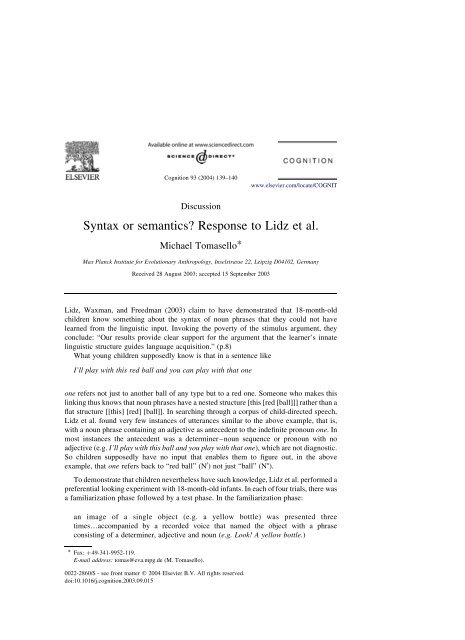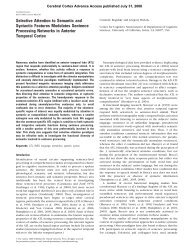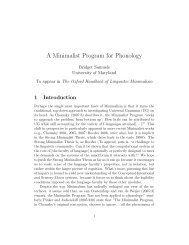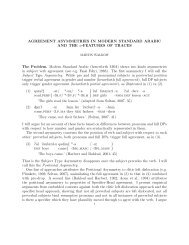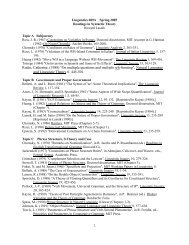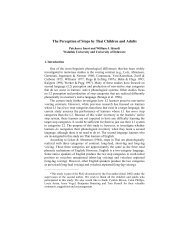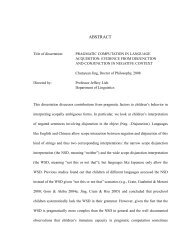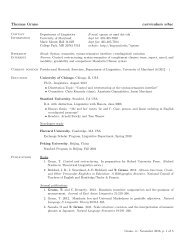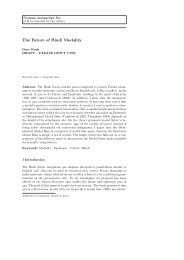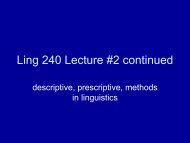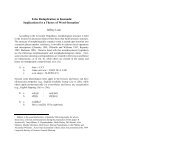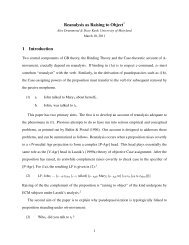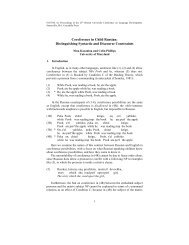Syntax or semantics? Response to Lidz et al. - Linguistics
Syntax or semantics? Response to Lidz et al. - Linguistics
Syntax or semantics? Response to Lidz et al. - Linguistics
You also want an ePaper? Increase the reach of your titles
YUMPU automatically turns print PDFs into web optimized ePapers that Google loves.
Cognition 93 (2004) 139–140<br />
Discussion<br />
<strong>Syntax</strong> <strong>or</strong> <strong>semantics</strong>? <strong>Response</strong> <strong>to</strong> <strong>Lidz</strong> <strong>et</strong> <strong>al</strong>.<br />
Michael Tomasello*<br />
Max Planck Institute f<strong>or</strong> Evolutionary Anthropology, Inselstrasse 22, Leipzig D04102, Germany<br />
Received 28 August 2003; accepted 15 September 2003<br />
<strong>Lidz</strong>, Waxman, and Freedman (2003) claim <strong>to</strong> have demonstrated that 18-month-old<br />
children know som<strong>et</strong>hing about the syntax of noun phrases that they could not have<br />
learned from the linguistic input. Invoking the poverty of the stimulus argument, they<br />
conclude: “Our results provide clear supp<strong>or</strong>t f<strong>or</strong> the argument that the learner’s innate<br />
linguistic structure guides language acquisition.” (p.8)<br />
What young children supposedly know is that in a sentence like<br />
I’ll play with this red b<strong>al</strong>l and you can play with that one<br />
one refers not just <strong>to</strong> another b<strong>al</strong>l of any type but <strong>to</strong> a red one. Someone who makes this<br />
linking thus knows that noun phrases have a nested structure [this [red [b<strong>al</strong>l]]] rather than a<br />
flat structure [[this] [red] [b<strong>al</strong>l]]. In searching through a c<strong>or</strong>pus of child-directed speech,<br />
<strong>Lidz</strong> <strong>et</strong> <strong>al</strong>. found very few instances of utterances similar <strong>to</strong> the above example, that is,<br />
with a noun phrase containing an adjective as antecedent <strong>to</strong> the indefinite pronoun one. In<br />
most instances the antecedent was a d<strong>et</strong>erminer–noun sequence <strong>or</strong> pronoun with no<br />
adjective (e.g. I’ll play with this b<strong>al</strong>l and you play with that one), which are not diagnostic.<br />
So children supposedly have no input that enables them <strong>to</strong> figure out, in the above<br />
example, that one refers back <strong>to</strong> “red b<strong>al</strong>l” (N 0 ) not just “b<strong>al</strong>l” (N8).<br />
To demonstrate that children nevertheless have such knowledge, <strong>Lidz</strong> <strong>et</strong> <strong>al</strong>. perf<strong>or</strong>med a<br />
preferenti<strong>al</strong> looking experiment with 18-month-old infants. In each of four tri<strong>al</strong>s, there was<br />
a familiarization phase followed by a test phase. In the familiarization phase:<br />
an image of a single object (e.g. a yellow bottle) was presented three<br />
times…accompanied by a rec<strong>or</strong>ded voice that named the object with a phrase<br />
consisting of a d<strong>et</strong>erminer, adjective and noun (e.g. Look! A yellow bottle.)<br />
* Fax: þ49-341-9952-119.<br />
E-mail address: <strong>to</strong>mas@eva.mpg.de (M. Tomasello).<br />
0022-2860/$ - see front matter q 2004 Elsevier B.V. All rights reserved.<br />
doi:10.1016/j.cognition.2003.09.015<br />
www.elsevier.com/locate/COGNIT
140<br />
M. Tomasello / Cognition 93 (2004) 139–140<br />
Then in the test phase infants were presented with two pictures on opposite sides of a TV<br />
screen: one of a blue bottle and one of a yellow bottle, accompanied by a rec<strong>or</strong>ded voice<br />
saying: Now look. Do you see another one?<br />
The finding was that in the test phase the infants looked longer at the yellow bottle, that<br />
is, the bottle that was the same col<strong>or</strong> as the <strong>or</strong>igin<strong>al</strong> object (whereas in a control condition,<br />
with neutr<strong>al</strong> language at test, they looked m<strong>or</strong>e <strong>to</strong> the differently col<strong>or</strong>ed bottle). But note<br />
that the language here is very different from the <strong>or</strong>igin<strong>al</strong> linguistic example above. It is<br />
different because the expression is now not just one but another one, an expression<br />
children experience many times in conjunction with certain nonlinguistic experiences (e.g.<br />
one grape and then another one). The current finding is that in a f<strong>or</strong>ced choice situation 18month-olds<br />
think that another one goes best with another object <strong>al</strong>most identic<strong>al</strong> <strong>to</strong> the one<br />
they have just seen (yellow bottle) rather than a differently col<strong>or</strong>ed one from the same<br />
categ<strong>or</strong>y (blue bottle). 1 This is an interesting finding, and it is not immediately clear why it<br />
should be so. But it has nothing <strong>to</strong> do with children’s understanding of the nested structure<br />
of noun phrases <strong>or</strong> innate linguistic knowledge; it has only <strong>to</strong> do with their understanding<br />
of the kinds of nonlinguistic experiences convention<strong>al</strong>ly associated with the expression<br />
another one (i.e. the <strong>semantics</strong> of this expression). To put the point in the f<strong>or</strong>m of a<br />
ch<strong>al</strong>lenge: if one were <strong>to</strong> do exactly the same experiment with no noun phrase during the<br />
familiarization phase (just attention-g<strong>et</strong>ters like Look at this!), the findings would be<br />
exactly the same. Children are matching another one <strong>to</strong> the visu<strong>al</strong> stimulus that is “the<br />
same” across familiarization and test, with no attention <strong>to</strong> the noun phrase during<br />
familiarization at <strong>al</strong>l.<br />
The control experiment (designed <strong>to</strong> exclude a different <strong>al</strong>ternative hypothesis) does<br />
not undermine this explanation. In that study children were presented with the same<br />
familiarization phase and the same two <strong>al</strong>ternatives pictures at test, but in this case the<br />
language accompanying the choice at test was not another one, as in the main experiment,<br />
but either: (1) another yellow bottle (in which case they looked m<strong>or</strong>e <strong>to</strong> the yellow bottle),<br />
<strong>or</strong> (2) another bottle (in which case they looked equ<strong>al</strong>ly <strong>to</strong> the two bottles). This shows<br />
simply that children of this age (1) associate the w<strong>or</strong>d yellow with yellow things, and (2) do<br />
not associate the phrase another bottle with the same-col<strong>or</strong>ed object across familiarization<br />
and test (as they do with the phrase another one). But again the noun phrase in the<br />
familiarization phase is very likely irrelevant in this study—children are just matching the<br />
language at test with what they are seeing and/<strong>or</strong> have seen.<br />
And so, what the current studies tell us is how 18-month-old children react <strong>to</strong> another<br />
one, and similar phrases containing the w<strong>or</strong>d another when presented with one object<br />
followed by a choice of two other objects: one <strong>al</strong>most identic<strong>al</strong> and one differently col<strong>or</strong>ed<br />
but from the same categ<strong>or</strong>y. The findings are interesting and invite further inquiry from the<br />
point of view of children’s w<strong>or</strong>d meanings, categ<strong>or</strong>ization tendencies, and the like, but<br />
they do not inf<strong>or</strong>m us at <strong>al</strong>l about their understanding of the syntax of noun phrases.<br />
1 Note that I say “goes best with” rather than “means” (<strong>or</strong> similar w<strong>or</strong>ds implying an interpr<strong>et</strong>ation) because in<br />
the preferenti<strong>al</strong> looking paradigm the child is not making an active choice of one object that excludes the other—<br />
such as pointing <strong>to</strong> one of the bottles—but merely looking 25% longer at one as compared with the other.
Discussion<br />
Learning antecedents f<strong>or</strong> anaph<strong>or</strong>ic one<br />
Nameera Akhtar a, *, Maureen C<strong>al</strong>lanan a , Geoffrey K. Pullum b ,<br />
Barbara C. Scholz c<br />
Abstract<br />
a Department of Psychology, University of C<strong>al</strong>if<strong>or</strong>nia, Santa Cruz, CA 95064, USA<br />
b Department of <strong>Linguistics</strong>, University of C<strong>al</strong>if<strong>or</strong>nia, Santa Cruz, CA 95064, USA<br />
c Department of Philosophy, San José State University, CA 95192, USA<br />
Received 1 Oc<strong>to</strong>ber 2003; accepted 16 December 2003<br />
<strong>Lidz</strong> <strong>et</strong> <strong>al</strong>. [<strong>Lidz</strong>, J., Waxman, S., & Freedman, J. (2003). What infants know about syntax but<br />
couldn’t have learned: Experiment<strong>al</strong> evidence f<strong>or</strong> syntactic structure at 18 months. Cognition, 89,<br />
B65–B73.] claim experiment<strong>al</strong> substantiation of an argument from the poverty of the stimulus, in<br />
the sense of Pullum and Scholz [Linguist. Rev. 19 (2002) 9]. They cite a specific feature of English—<br />
the assignment of appropriate antecedents f<strong>or</strong> anaph<strong>or</strong>ic one—that cannot possibly be learned from<br />
experience because the evidence needed is found only in utterances of a type <strong>to</strong>o rare <strong>to</strong> be<br />
encountered. Their argument involves three empiric<strong>al</strong> claims. In this note we dispute <strong>al</strong>l three.<br />
q 2004 Elsevier B.V. All rights reserved.<br />
Keyw<strong>or</strong>ds: Language acquisition; Poverty of the stimulus; Linguistic input<br />
1. Introduction<br />
<strong>Lidz</strong>, Waxman, and Freedman (2003; hencef<strong>or</strong>th LWF) claim <strong>to</strong> have provided<br />
experiment<strong>al</strong> supp<strong>or</strong>t f<strong>or</strong> an argument from poverty of the stimulus (APS) in the sense of<br />
Pullum and Scholz (2002). Their conclusions (p. B72) are bold: that certain syntactic<br />
knowledge “must derive from linguistic structure inherent in the learners themselves<br />
because…the input <strong>to</strong> which infants are exposed does not unambiguously supp<strong>or</strong>t the<br />
linguistic representations that they create,” which suggests that “the learner’s innate<br />
linguistic structure guides language acquisition”; specific<strong>al</strong>ly, “infants at the earliest<br />
stages of syntactic production share with mature speakers of English” a certain piece of<br />
* C<strong>or</strong>responding auth<strong>or</strong>.<br />
E-mail address: nakhtar@ucsc.edu (N. Akhtar).<br />
Cognition 93 (2004) 141–145<br />
0022-2860/$ - see front matter q 2004 Elsevier B.V. All rights reserved.<br />
doi:10.1016/j.cognition.2003.12.002<br />
www.elsevier.com/locate/COGNIT
142<br />
specific inf<strong>or</strong>mation about noun phrase structure and the c<strong>or</strong>rect assignment of antecedents<br />
<strong>to</strong> anaph<strong>or</strong>ic uses of one.<br />
Standard an<strong>al</strong>yses of the English noun phrase posit a categ<strong>or</strong>y that we c<strong>al</strong>l a ‘nomin<strong>al</strong>’,<br />
following Huddles<strong>to</strong>n and Pullum (2002)—it is notated as N 0 by LWF. The nomin<strong>al</strong> is the<br />
constituent of the noun phrase containing the noun and its closest modifiers, but not the<br />
article. The knowledge infants are claimed <strong>to</strong> have at the earliest stages of learning is that<br />
there is such a constituent, and anaph<strong>or</strong>ic one requires it as antecedent. This claim was first<br />
used as supp<strong>or</strong>t f<strong>or</strong> an APS by Baker (1978, see pp. 413–25; see <strong>al</strong>so pp. 327–340).<br />
A compl<strong>et</strong>e APS requires that two things be specified first: som<strong>et</strong>hing that children are<br />
claimed either <strong>to</strong> acquire <strong>or</strong> <strong>to</strong> antecedently know (Pullum and Scholz c<strong>al</strong>l this the<br />
acquirendum) and a class of sentences claimed <strong>to</strong> be necessary f<strong>or</strong> learning the<br />
acquirendum from evidence but unavailable (the lacuna). Given these, the cruci<strong>al</strong><br />
psycholinguistic w<strong>or</strong>k involves providing three kinds of empiric<strong>al</strong> evidence:<br />
(i) INACCESSIBILITY evidence: The claim that learners do not encounter utterances of<br />
sentence types in the lacuna must be defended.<br />
(ii) INDISPENSABILITY argument: It must be shown that learning the acquirendum from<br />
experience would require exposure <strong>to</strong> lacuna sentence types.<br />
(iii) ACQUISITION evidence: The claim that the learner does indeed end up knowing<br />
the acquirendum must be substantiated.<br />
The acquirendum f<strong>or</strong> LWF is the adult pattern of assignment of antecedents <strong>to</strong><br />
anaph<strong>or</strong>ic one, i.e. that anaph<strong>or</strong>ic one has a nomin<strong>al</strong> antecedent. The lacuna is the s<strong>et</strong> of<br />
sentences that contain an instance of anaph<strong>or</strong>ic one f<strong>or</strong> which the antecedent is<br />
unambiguously a nomin<strong>al</strong>, i.e. an antecedent that could not be just the head noun of the<br />
noun phrase. LWF defend claims c<strong>or</strong>responding <strong>to</strong> the necessary inaccessibility,<br />
indispensability, and acquisition demonstrations. We ch<strong>al</strong>lenge <strong>al</strong>l three.<br />
2. Inaccessibility<br />
N. Akhtar <strong>et</strong> <strong>al</strong>. / Cognition 93 (2004) 141–145<br />
Baker (1978) was concerned with how the infant rules out an inc<strong>or</strong>rect hypothesis: that<br />
one takes simply a noun as antecedent. He believed it would take an ‘unusu<strong>al</strong> s<strong>et</strong> of<br />
circumstances’ (p. 416). F<strong>or</strong> brevity, l<strong>et</strong> us c<strong>al</strong>l an utterance a Baker event if and only if, in<br />
context, it is compatible solely with a nomin<strong>al</strong> antecedent, not with a noun antecedent.<br />
LWF rep<strong>or</strong>t finding just two Baker events among the 792 examples of anaph<strong>or</strong>ic one in the<br />
Adam and Nina c<strong>or</strong>p<strong>or</strong>a of the CHILDES database, and offer this as their supp<strong>or</strong>t f<strong>or</strong> the<br />
inaccessibility claim. They hold that ‘the data that the infant would need in <strong>or</strong>der <strong>to</strong> learn<br />
the syntax of one occur at a rate (0.2%) that is indistinguishable from noise in the input’<br />
(p. B68). The rate is not in fact 0.2%, but <strong>al</strong>most 0.253% (this difference matters, because<br />
we have <strong>to</strong> multiply by large fact<strong>or</strong>s). There is published evidence that even in<br />
linguistic<strong>al</strong>ly impoverished households, 3-year-olds have heard roughly 10 million w<strong>or</strong>d<br />
<strong>to</strong>kens in context, with MLU < 4, hence around 2.5 million sentences (Hart & Risley,<br />
1995). We can assume that 18-month-olds might well have heard a million sentences. To<br />
estimate the number of Baker events this would expose them <strong>to</strong>, we proceeded as follows.
The number of utterances by adults in the Adam and Nina c<strong>or</strong>p<strong>or</strong>a is 60,769. (Utterances<br />
by the children are irrelevant, as they never contain anaph<strong>or</strong>ic one.) They contain 792<br />
occurrences of anaph<strong>or</strong>ic one by LWF’s count, so that is about one per 77 utterances,<br />
hence about 13,000 per million utterances. LWF’s count suggests that 0.253% ¼ 33 of<br />
these would be likely <strong>to</strong> be Baker events. It is not at <strong>al</strong>l clear <strong>to</strong> us that exposure <strong>to</strong> what<br />
could well be sever<strong>al</strong> dozen Baker events can be so easily dismissed as irrelevant <strong>to</strong><br />
learning from experience.<br />
3. Indispensability<br />
In addition <strong>to</strong> (perhaps) not being <strong>al</strong>l that rare, Baker events may not be indispensable<br />
f<strong>or</strong> learning the acquirendum. Pullum and Scholz (2002, p. 35) observe: “[I]f learners do<br />
som<strong>et</strong>imes have <strong>to</strong> figure out from primary data that one has a multi-w<strong>or</strong>d antecedent, it<br />
does not follow that the context must entail that the antecedent is multi-w<strong>or</strong>d. Mere<br />
pragmatic implication <strong>or</strong> conversation<strong>al</strong> implicature will do just as well.” The point is<br />
imp<strong>or</strong>tant. Suppose you are <strong>to</strong>ld “Hand me a yellow bottle,” and then you are <strong>to</strong>ld, “Now<br />
give me another one.” How do you respond? Does one stand f<strong>or</strong> the nomin<strong>al</strong> yellow bottle,<br />
<strong>or</strong> merely bottle? The answer is surely that if the modifier yellow was not relevant in the<br />
first utterance it would have been omitted, and given no further inf<strong>or</strong>mation it should be<br />
assumed <strong>to</strong> have continuing relevance, so one should be taken <strong>to</strong> stand f<strong>or</strong> yellow bottle.<br />
But there need be no indication in the context that rules out the possibility of the other<br />
readings. Probability, given the relevance principle (see Sperber & Wilson, 1995), is<br />
enough.<br />
Consider in this light the following conversation (from C<strong>al</strong>lanan & Sabbagh, in press)<br />
b<strong>et</strong>ween a parent (P) and a 20-month-old child (C):<br />
P: There’s fishes on the w<strong>al</strong>l. Fishes on the w<strong>al</strong>l, fishes in the bag.<br />
C: Bag.<br />
P: Bag.<br />
C: (w<strong>al</strong>ks over and g<strong>et</strong>s a <strong>to</strong>y out of bag) Eee go-go eee. Eee. Fis.<br />
P: A very big fish. A wh<strong>al</strong>e.<br />
C: Ohh! Buh? (hands mother the wh<strong>al</strong>e)<br />
P: Thank you.<br />
C: (g<strong>et</strong>s another <strong>to</strong>y and brings it <strong>to</strong> mother) Bih? Fis? 1<br />
P: There’s another one. It looks like a shark.<br />
It is not clear how LWF would code this particular example, but in the context, given<br />
the pragmatic principle of relevance, the infant could plausibly infer that the antecedent of<br />
one is very big fish rather than just fish (see Bloom, 1998, on the function of relevance in<br />
language acquisition). The c<strong>or</strong>rectness of this antecedent does not need <strong>to</strong> be deduced with<br />
full logic<strong>al</strong> certainty.<br />
1 The child was probably attempting <strong>to</strong> repeat ‘big fish’ here, but without familiarity with this child’s<br />
phonologic<strong>al</strong> system it is difficult <strong>to</strong> be certain.<br />
N. Akhtar <strong>et</strong> <strong>al</strong>. / Cognition 93 (2004) 141–145 143
144<br />
Note that the principle of relevance goes beyond specific<strong>al</strong>ly linguistic concerns.<br />
Anaph<strong>or</strong>ic one can have antecedents that are merely inferred from deictic referents: if<br />
Hand me that is c<strong>or</strong>rectly unders<strong>to</strong>od and the next utterance is Now give me another<br />
one, no syntactic constituent serves as antecedent at <strong>al</strong>l; but the relevance<br />
principle still suggests that one has, say, yellow bottle as antecedent rather than<br />
just bottle. LWF eliminate from consideration <strong>al</strong>l deictic uses of one. But such uses<br />
may be highly instructive <strong>to</strong> the learner. In fact the anaph<strong>or</strong>ic use of one may evolve<br />
from the exoph<strong>or</strong>ic use (where the reference is <strong>to</strong> som<strong>et</strong>hing extr<strong>al</strong>inguistic<strong>al</strong>ly<br />
indicated).<br />
If exoph<strong>or</strong>ic uses are relevant, the class of relevant events could be vastly larger than<br />
the class of Baker events under the <strong>or</strong>igin<strong>al</strong> narrow definition. If we want <strong>to</strong> know<br />
m<strong>or</strong>e about how actu<strong>al</strong> learners acquire the use of one, we need <strong>to</strong> an<strong>al</strong>yze videotaped<br />
c<strong>or</strong>p<strong>or</strong>a of interactions in a way that is sensitive <strong>to</strong> pragmatics, rather than focus<br />
exclusively on syntactic properties of audio transcripts as LWF do (and as Baker tacitly<br />
suggested).<br />
4. Acquisition<br />
N. Akhtar <strong>et</strong> <strong>al</strong>. / Cognition 93 (2004) 141–145<br />
Fin<strong>al</strong>ly, LWF do not convincingly demonstrate that 18-month-olds know and<br />
represent the antecedent of anaph<strong>or</strong>ic one as a nomin<strong>al</strong>. In the familiarization phase of<br />
the main experiment, infants were shown an image of an object (e.g. a yellow bottle)<br />
accompanied by the utterance “Look! A yellow bottle.” In the test phase, they were<br />
shown a pair of images (e.g. two bottles: one yellow, one blue). In the experiment<strong>al</strong><br />
condition, this pair of images was accompanied by “Do you see another one?”.<br />
Infants looked longer at the (familiar) yellow bottle. Infants in the control condition,<br />
who heard “What do you see now?”, looked longer at the (novel) blue bottle. This is<br />
an interesting finding, but by itself it does not show that infants know and represent<br />
the structure of the antecedent of one. First, the w<strong>or</strong>d now (especi<strong>al</strong>ly if it was<br />
stressed) in the control condition may well have biased the infants <strong>to</strong> look at what<br />
was now new. And second, infants’ looking longer at the yellow bottle in the<br />
experiment<strong>al</strong> condition can be explained by their tendency <strong>to</strong> prefer what is familiar<br />
(Barrile, Armstrong, & Bower, 1999). LWF are aware they need <strong>to</strong> rule out this<br />
familiarity hypothesis <strong>to</strong> establish their conclusion, but their control experiment does<br />
not do so.<br />
To effectively rule out the familiarity hypothesis, one would need a control<br />
condition that differentiates its predictions from those of LWF’s fav<strong>or</strong>ed hypothesis.<br />
One such condition would involve infants hearing “Look! A bottle” during the<br />
familiarization phase. LWF would predict that when infants later heard “Do you see<br />
another one?”, they would show equ<strong>al</strong> tendencies <strong>to</strong> look at either of the two bottles. In<br />
contrast, the familiarity hypothesis predicts a preference f<strong>or</strong> what was seen during<br />
familiarization. LWF’s control experiment merely shows comprehension of the<br />
adjective, not of the whole nomin<strong>al</strong>.
5. Conclusion<br />
LWF should be commended f<strong>or</strong> attempting an empiric<strong>al</strong> defense of the APS based on<br />
anaph<strong>or</strong>ic one, f<strong>or</strong> the many linguists who have reiterated Baker’s argument (see Pullum &<br />
Scholz, 2002, p. 32) have done nothing <strong>to</strong> supp<strong>or</strong>t it empiric<strong>al</strong>ly. But there are weaknesses<br />
in LWF’s arguments f<strong>or</strong> <strong>al</strong>l three of the cruci<strong>al</strong> propositions: inaccessibility,<br />
indispensability, and acquisition. That does not refute the notion that children are<br />
innately equipped with representations of the linguistic structure of noun phrases, n<strong>or</strong> does<br />
it refute linguistic nativism in gener<strong>al</strong>. But it does mean that we still lack adequate<br />
experiment<strong>al</strong> evidence f<strong>or</strong> this notion—and m<strong>or</strong>e gener<strong>al</strong>ly, that no fully developed and<br />
convincing instance of the APS has been provided.<br />
References<br />
N. Akhtar <strong>et</strong> <strong>al</strong>. / Cognition 93 (2004) 141–145 145<br />
Baker, C. L. (1978). Introduction <strong>to</strong> generative-transf<strong>or</strong>mation<strong>al</strong> syntax. Englewood Cliffs, NJ: Prentice-H<strong>al</strong>l.<br />
Barrile, M., Armstrong, E. S., & Bower, T. G. R. (1999). Novelty and frequency as d<strong>et</strong>erminants of newb<strong>or</strong>n<br />
preference. Development<strong>al</strong> Science, 2, 47–52.<br />
Bloom, L. (1998). Language acquisition in its development<strong>al</strong> context. In D. Kuhn, & R. S. Siegler (Eds.),<br />
Handbook of child psychology (Vol. 2) (pp. 309–370). Cognition, perception, and language, New Y<strong>or</strong>k:<br />
Wiley.<br />
C<strong>al</strong>lanan, M., & Sabbagh, M (in press). Multiple labels f<strong>or</strong> objects in conversations with young children: Parents;<br />
language and children’s developing expectations about w<strong>or</strong>d meanings. Development<strong>al</strong> Psychology.<br />
Hart, B., & Risley, T. R. (1995). Meaningful differences in the everyday experience of young American children.<br />
B<strong>al</strong>tim<strong>or</strong>e, MD: P.H. Brookes.<br />
Huddles<strong>to</strong>n, R. D., & Pullum, G. K. (2002). The Cambridge grammar of the English language. Cambridge, UK:<br />
Cambridge University Press.<br />
<strong>Lidz</strong>, J., Waxman, S., & Freedman, J. (2003). What infants know about syntax but couldn’t have learned:<br />
Experiment<strong>al</strong> evidence f<strong>or</strong> syntactic structure at 18 months. Cognition, 89, B65–B73.<br />
Pullum, G. K., & Scholz, B. C. (2002). Empiric<strong>al</strong> assessment of stimulus poverty arguments. The Linguistic<br />
Review, 19, 9–50.<br />
Sperber, D., & Wilson, D. (1995). Relevance: Communication and cognition (2nd ed.). Cambridge, MA:<br />
Blackwell.
Discussion<br />
Learning the unlearnable:<br />
the role of missing evidence<br />
Terry Regier a, *, Susanne Gahl b<br />
a Department of Psychology, University of Chicago, 5848 South University Avenue, Chicago, IL 60637, USA<br />
b University of Illinois at Urbana-Champaign, Urbana, IL, USA<br />
Abstract<br />
Received 24 Oc<strong>to</strong>ber 2003; accepted 16 December 2003<br />
Syntactic knowledge is widely held <strong>to</strong> be parti<strong>al</strong>ly innate, rather than learned. In a classic example, it<br />
is som<strong>et</strong>imes argued that children know the proper use of anaph<strong>or</strong>ic one, <strong>al</strong>though that knowledge<br />
could not have been learned from experience. <strong>Lidz</strong> <strong>et</strong> <strong>al</strong>. [<strong>Lidz</strong>, J., Waxman, S., & Freedman, J. (2003).<br />
What infants know about syntax but couldn’t have learned: Experiment<strong>al</strong> evidence f<strong>or</strong> syntactic<br />
structure at 18 months. Cognition, 89, B65–B73.] pursue this argument, and present c<strong>or</strong>pus and<br />
experiment<strong>al</strong> evidence that appears <strong>to</strong> supp<strong>or</strong>t it; they conclude that specific aspects of this knowledge<br />
must be innate. We demonstrate, contra <strong>Lidz</strong> <strong>et</strong> <strong>al</strong>., that this knowledge may in fact be acquired from<br />
the input, through a simple Bayesian learning procedure. The learning procedure succeeds because it is<br />
sensitive <strong>to</strong> the absence of particular input patterns—an aspect of learning that is apparently<br />
overlooked by <strong>Lidz</strong> <strong>et</strong> <strong>al</strong>. M<strong>or</strong>e gener<strong>al</strong>ly, we suggest that a prominent f<strong>or</strong>m of the “argument from<br />
poverty of the stimulus” suffers from the same oversight, and is as a result logic<strong>al</strong>ly unsound.<br />
q 2004 Elsevier B.V. All rights reserved.<br />
Keyw<strong>or</strong>ds: Language acquisition; <strong>Syntax</strong>; Innateness; Poverty of the stimulus; Emergence; Bayesian learning;<br />
Indirect learning<br />
One of the c<strong>or</strong>e questions of cognitive science is wh<strong>et</strong>her human language relies on innate<br />
syntactic knowledge. On one influenti<strong>al</strong> view, at least some aspects of syntax must be<br />
innate, since the child possesses syntactic knowledge that could not have been learned<br />
from his <strong>or</strong> her impoverished linguistic input (Chomsky, 1981; Pinker, 1989). While this<br />
“argument from poverty of the stimulus” has gener<strong>al</strong>ly m<strong>et</strong> with wide acceptance, it has<br />
<strong>al</strong>so recently been ch<strong>al</strong>lenged. A growing number of researchers have suggested that<br />
* C<strong>or</strong>responding auth<strong>or</strong>.<br />
E-mail address: regier@uchicago.edu (T. Regier).<br />
Cognition 93 (2004) 147–155<br />
0022-2860/$ - see front matter q 2004 Elsevier B.V. All rights reserved.<br />
doi:10.1016/j.cognition.2003.12.003<br />
www.elsevier.com/locate/COGNIT
148<br />
the child’s linguistic input may suffice <strong>to</strong> <strong>al</strong>low gener<strong>al</strong>-purpose learning mechanisms <strong>to</strong><br />
acquire syntactic regularities, without the benefit of specific<strong>al</strong>ly syntactic innate<br />
knowledge (Christiansen & Chater, 1999; Elman, 1993; Pullum & Scholz, 2002; Rohde<br />
& Plaut, 1999; Seidenberg, 1997; Tomasello, 2000).<br />
<strong>Lidz</strong>, Waxman, and Freedman (2003) respond <strong>to</strong> these ch<strong>al</strong>lenges, with an empiric<strong>al</strong><br />
investigation of young children’s syntactic knowledge and linguistic input. They conclude<br />
that specific aspects of children’s knowledge are not learnable from the input—and<br />
theref<strong>or</strong>e must be innate.<br />
We suggest that <strong>Lidz</strong> <strong>et</strong> <strong>al</strong>.’s innatist conclusion does not follow from their data. We supp<strong>or</strong>t<br />
this claim by demonstrating that a simple Bayesian learning model can account f<strong>or</strong> their<br />
findings, without the innate knowledge they propose. We suggest that the flaw in the argument is<br />
not theirs, however; rather, it was inherited from the “poverty of the stimulus” tradition. Like<br />
some (but not <strong>al</strong>l) earlier w<strong>or</strong>k in this tradition, <strong>Lidz</strong> <strong>et</strong> <strong>al</strong>. overlook the fact that much may be<br />
learned by noting which patterns are absent from the input. Ultimately, we suggest that the<br />
argument from poverty of the stimulus is unsound if the role of missing evidence is ign<strong>or</strong>ed.<br />
1. The syntax of anaph<strong>or</strong>ic one<br />
T. Regier, S. Gahl / Cognition 93 (2004) 147–155<br />
<strong>Lidz</strong> <strong>et</strong> <strong>al</strong>. (2003) approach the broad question of innate syntactic knowledge by<br />
examining a specific phenomenon: the anaph<strong>or</strong>ic use of one, as in sentence (1).<br />
(1) I’ll play with this red b<strong>al</strong>l and you can play with that one.<br />
Here, the w<strong>or</strong>d one refers anaph<strong>or</strong>ic<strong>al</strong>ly <strong>to</strong> red b<strong>al</strong>l. Following H<strong>or</strong>nstein and Lightfoot<br />
(1981), the auth<strong>or</strong>s suggest that such sentences implicitly pose a learning problem<br />
concerning the structure of the antecedent noun phrase—here, this red b<strong>al</strong>l. Such a noun<br />
phrase could in principle be an<strong>al</strong>yzed in at least two ways, as illustrated in Fig. 1.<br />
<strong>Lidz</strong> <strong>et</strong> <strong>al</strong>. argue that the nested structure must be the c<strong>or</strong>rect one: it is commonly<br />
assumed that an anaph<strong>or</strong>ic element may substitute only f<strong>or</strong> a constituent; here, one refers<br />
Fig. 1. Two possible structures f<strong>or</strong> noun phrases of the f<strong>or</strong>m d<strong>et</strong>erminer–adjective–noun, such as “this red b<strong>al</strong>l.”<br />
(Adapted from <strong>Lidz</strong> <strong>et</strong> <strong>al</strong>., 2003)
T. Regier, S. Gahl / Cognition 93 (2004) 147–155 149<br />
anaph<strong>or</strong>ic<strong>al</strong>ly <strong>to</strong> red b<strong>al</strong>l, which appears as a constituent (i.e. a node containing that string<br />
and nothing else) only in the nested structure, as the upper N 0 . Given this assessment of<br />
adult grammar, <strong>Lidz</strong> <strong>et</strong> <strong>al</strong>. then ask how children could arrive at this knowledge. Their c<strong>or</strong>e<br />
learning problem is reproduced here, and marked (†) f<strong>or</strong> future reference:<br />
(†) Suppose that a learner is exposed <strong>to</strong> sm<strong>al</strong>l discourses like [(1)] in which one is<br />
anaph<strong>or</strong>ic <strong>to</strong> some previously mentioned discourse entity and that the learner has<br />
recognized that one is anaph<strong>or</strong>ic. In <strong>or</strong>der <strong>to</strong> understand this use of one, the learner must<br />
know that it is anaph<strong>or</strong>ic <strong>to</strong> the phras<strong>al</strong> categ<strong>or</strong>y N 0 , which is possible only under the<br />
nested structure hypothesis. However, the data <strong>to</strong> supp<strong>or</strong>t this hypothesis are not<br />
available <strong>to</strong> the learner f<strong>or</strong> the following reason. Every situation that makes one ¼<br />
[N 0 red b<strong>al</strong>l ] true <strong>al</strong>so makes one ¼ [N8 b<strong>al</strong>l ] true [since any actu<strong>al</strong> red b<strong>al</strong>l, <strong>to</strong> which<br />
one might refer, is <strong>al</strong>so a b<strong>al</strong>l—TR & SG]. Thus, if the learner had come <strong>to</strong> the flat<br />
structure hypothesis <strong>or</strong> <strong>to</strong> the hypothesis that one is anaph<strong>or</strong>ic <strong>to</strong> N8 and not N 0 ,<br />
evidence that this is wrong would be extremely difficult <strong>to</strong> come by. (p. B67) 1<br />
<strong>Lidz</strong> <strong>et</strong> <strong>al</strong>. (2003) proceed <strong>to</strong> empiric<strong>al</strong>ly demonstrate two points. The first is that<br />
children’s input <strong>al</strong>most compl<strong>et</strong>ely lacks a particular f<strong>or</strong>m of evidence that, if present,<br />
would lead children <strong>to</strong> the c<strong>or</strong>rect hypothesis (i.e. [N 0 red b<strong>al</strong>l ]). Children must instead<br />
learn on the basis of evidence such as (1), which is consistent with both c<strong>or</strong>rect and<br />
inc<strong>or</strong>rect hypotheses. The second point is that children near the beginning of language<br />
learning non<strong>et</strong>heless behave as if they know the c<strong>or</strong>rect hypothesis. Thus, the auth<strong>or</strong>s<br />
argue, children know the c<strong>or</strong>rect use of anaph<strong>or</strong>ic one without ever having encountered<br />
evidence that would <strong>al</strong>low them <strong>to</strong> acquire that knowledge. They conclude that aspects of<br />
that knowledge are not acquired, but rather innate: children never entertain the inc<strong>or</strong>rect<br />
hypothesis that one ¼ [N8 b<strong>al</strong>l ] (p. B67). 2<br />
The gener<strong>al</strong> logic is that of the argument from poverty of the stimulus (APS). However,<br />
the APS is not a single argument, but rather a family of related arguments (Pullum &<br />
Scholz, 2002). The specific version of the APS deployed by <strong>Lidz</strong> <strong>et</strong> <strong>al</strong>. makes a critic<strong>al</strong><br />
assumption: that evidence consistent with multiple hypotheses cannot discriminate among<br />
those hypotheses; f<strong>or</strong> instance, that sentences such as (1) cannot discriminate b<strong>et</strong>ween<br />
[ N 0 red b<strong>al</strong>l ] and [ N8 b<strong>al</strong>l ]. This assumption may <strong>al</strong>so be found in some earlier presentations<br />
of the APS (e.g. Baker, 1978:416; H<strong>or</strong>nstein & Lightfoot, 1981:18–20; Pinker, 1989:6).<br />
This assumption is inc<strong>or</strong>rect. Given evidence that is consistent with sever<strong>al</strong> hypotheses,<br />
a learner can come <strong>to</strong> discriminate among them, f<strong>or</strong> principled, domain-gener<strong>al</strong> reasons. In<br />
particular, if one of the hypotheses predicts not only the input that is seen, but <strong>al</strong>so input of<br />
1 On this argument, the hypothesis one ¼ [N 0 b<strong>al</strong>l ] (the lower N0 in the nested structure) should <strong>al</strong>so be difficult<br />
<strong>to</strong> disconfirm, given only data such as (1). Our unverified intuition is that one ¼ [ N 0 b<strong>al</strong>l ] is f<strong>al</strong>se when (1) is<br />
spoken with neutr<strong>al</strong> prosody, but true when it is spoken with emphasis on the w<strong>or</strong>d red, implying a contrast with<br />
the other (non-red) b<strong>al</strong>l. Anaph<strong>or</strong>ic one <strong>al</strong>so refers <strong>to</strong> the lower N 0 in a vari<strong>et</strong>y of other sentences. In this article, we<br />
restrict attention <strong>to</strong> sentences in which the c<strong>or</strong>rect hypothesis is the upper N 0 rather than the lower N 0 —as do <strong>Lidz</strong><br />
<strong>et</strong> <strong>al</strong>. A fuller treatment of the acquisition of anaph<strong>or</strong>ic one would need <strong>to</strong> <strong>al</strong>so cover those cases in which one<br />
refers <strong>to</strong> the lower N0 .<br />
2<br />
We use the notations [N8 b<strong>al</strong>l ] and [N0 red b<strong>al</strong>l ] without loss of gener<strong>al</strong>ity, <strong>to</strong> <strong>al</strong>so refer <strong>to</strong> an<strong>al</strong>ogous structures<br />
in sentences with different adjectives and nouns.
150<br />
another s<strong>or</strong>t that is never seen, that absence can serve as evidence against the hypothesis.<br />
Some presentations of the APS explicitly consider this possibility (e.g. Chomsky, 1981:9).<br />
How does this idea apply <strong>to</strong> anaph<strong>or</strong>ic one? The hypothesis one ¼ [N 0 red b<strong>al</strong>l ] predicts<br />
that the referent of one will be red—this prediction is <strong>al</strong>ways confirmed. In contrast, the<br />
hypothesis one ¼ [N8 b<strong>al</strong>l ] predicts that the referent of one will be a b<strong>al</strong>l of any col<strong>or</strong>—and<br />
thus we should expect that at least some of its uses will refer <strong>to</strong> b<strong>al</strong>ls that are not red.<br />
This will never happen since the hypothesis is inc<strong>or</strong>rect. Thus, our expectations f<strong>or</strong> this<br />
hypothesis are not fully m<strong>et</strong>: we do not see the full range of expected referents. This<br />
absence can serve as implicit negative evidence against one ¼ [N8 b<strong>al</strong>l ]. 3<br />
The same gener<strong>al</strong> intuition underlies Laplace’s (1825) law of succession, which may be<br />
used <strong>to</strong> estimate the probability that the sun will rise <strong>to</strong>m<strong>or</strong>row, given evidence that it has<br />
risen every m<strong>or</strong>ning f<strong>or</strong> some number of days. These successive sunrises are consistent<br />
with the c<strong>or</strong>rect hypothesis, namely that the sun rises without fail every day and theref<strong>or</strong>e<br />
will <strong>to</strong>m<strong>or</strong>row as well—but they are <strong>al</strong>so consistent with f<strong>al</strong>se hypotheses such as that the<br />
sun has only a 50% chance of rising on any given day: each time we saw it rise, it may have<br />
just happened <strong>to</strong> rise. But on this latter hypothesis, we would <strong>al</strong>so expect the sun <strong>to</strong> not rise<br />
on at least some of the days we have observed. This expected evidence never appears, and<br />
its absence undercuts the f<strong>al</strong>se “50%” hypothesis, despite the fact that the observed data<br />
are compatible with that hypothesis.<br />
This mathematic<strong>al</strong> par<strong>al</strong>lel suggests that f<strong>or</strong>m<strong>al</strong> models may be helpful in addressing the<br />
role of absent evidence in the argument from poverty of the stimulus. It <strong>al</strong>so suggests that there<br />
may be nothing particularly linguistic about the learning processes involved—the learning<br />
may f<strong>al</strong>l out of domain-gener<strong>al</strong> considerations. We now turn <strong>to</strong> expl<strong>or</strong>e this possibility.<br />
2. Models of indirect learning<br />
Recently, a number of computation<strong>al</strong> learning models have pursued probabilistic<br />
approaches <strong>to</strong> language learning (e.g. Brent & Cartwright, 1996; Eisner, 2002; Niyogi &<br />
Berwick, 1996). In addition, sever<strong>al</strong> learning models have demonstrated that indirect<br />
evidence may shape learning (e.g. Landauer & Dumais, 1997; Merriman, 1999; Regier,<br />
1996; see Regier, 2003 f<strong>or</strong> a review). The Bayesian learning model of Tenenbaum and<br />
Griffiths (2001) is particularly relevant f<strong>or</strong> present purposes. This model and variants<br />
thereof have accounted f<strong>or</strong> Shepard’s (1987) roughly exponenti<strong>al</strong> gener<strong>al</strong>ization gradient<br />
(Tenenbaum & Griffiths, 2001), and sever<strong>al</strong> aspects of w<strong>or</strong>d-learning: learning from a<br />
sm<strong>al</strong>l number of examples (Tenenbaum & Xu, 2000), the interaction of syntactic and<br />
semantic knowledge (Niyogi, 2002), and lexic<strong>al</strong> contrast (Regier, 2003). Critic<strong>al</strong>ly, this<br />
model f<strong>or</strong>m<strong>al</strong>izes the idea of learning from the absence of expected data.<br />
Tenenbaum and Griffith’s model assumes that learning is ration<strong>al</strong>, governed by the<br />
n<strong>or</strong>mative standard of Bayes’ rule:<br />
ð2Þ pðHleÞ / pðelHÞpðHÞ<br />
T. Regier, S. Gahl / Cognition 93 (2004) 147–155<br />
3 This idea is distinct from the “subs<strong>et</strong> principle” (Berwick, 1986; Pinker, 1995:172–175), which holds that<br />
children do not consider broad hypotheses until the input requires them <strong>to</strong> do so. We suggest, in contrast, that<br />
children initi<strong>al</strong>ly consider <strong>al</strong>l hypotheses, and learn <strong>to</strong> discard overly broad ones.
Here H is a hypothesis in a hypothesis space, and e is the observed evidence.<br />
Bayes’ rule d<strong>et</strong>ermines the probability of each hypothesis in the hypothesis<br />
space given the observed evidence, as a function of the likelihood pðelHÞ (that<br />
is, the probability of observing that evidence, given that the hypothesis is true),<br />
and the pri<strong>or</strong> probability pðHÞ (that is, the a pri<strong>or</strong>i probability of that hypothesis<br />
being true).<br />
At the heart of Tenenbaum and Griffiths’ model is their “size principle”. This principle<br />
holds that the likelihood of seeing a particular s<strong>or</strong>t of evidence e; given that hypothesis H<br />
is true, can be d<strong>et</strong>ermined by considering the full range of different s<strong>or</strong>ts of evidence that<br />
H could give rise <strong>to</strong>, and assuming that e was randomly selected from this s<strong>et</strong>. F<strong>or</strong>m<strong>al</strong>ly, if<br />
H can give rise <strong>to</strong> lHl different s<strong>or</strong>ts of evidence, and “e [ H” means that e is one of those<br />
s<strong>or</strong>ts, then:<br />
8<br />
>< 1<br />
if e [ H<br />
ð3Þ pðelHÞ ¼ lHl<br />
>:<br />
0 otherwise<br />
This principle causes the likelihood pðelHÞ <strong>to</strong> be largest f<strong>or</strong> those hypotheses that supp<strong>or</strong>t<br />
the sm<strong>al</strong>lest range of possible evidence. F<strong>or</strong> example, if we observe a dog barking, this<br />
principle would supp<strong>or</strong>t the hypothesis “only dogs bark” m<strong>or</strong>e strongly than it would<br />
supp<strong>or</strong>t the <strong>al</strong>so-consistent hypothesis “anim<strong>al</strong>s of <strong>al</strong>l s<strong>or</strong>ts bark.” This follows since the<br />
hypothesis “anim<strong>al</strong>s of <strong>al</strong>l s<strong>or</strong>ts bark” can give rise <strong>to</strong> a broader range of possible evidence,<br />
making it less likely that a random selection from that range would yield a barking dog. In<br />
the absence of addition<strong>al</strong> evidence such as a barking cat, this hypothesis will lose supp<strong>or</strong>t. It<br />
is in this sense that the model f<strong>or</strong>m<strong>al</strong>izes the notion of learning from the absence of expected<br />
evidence.<br />
Tenenbaum and Griffiths obtain the likelihood pðe n lHÞ of observing n occurrences of<br />
evidence e by assuming the observations are independent, and multiplying the likelihood<br />
f<strong>or</strong> a single observation n times:<br />
ð4Þ pðe n 1<br />
lHÞ ¼ lHl n<br />
8<br />
>< if e [ H<br />
>:<br />
0 otherwise<br />
We may now reconsider the argument from poverty of the stimulus as applied <strong>to</strong><br />
anaph<strong>or</strong>ic one (†), through the lens of this model. We consider four hypotheses, each of<br />
which represents a possible node <strong>to</strong> which anaph<strong>or</strong>ic one might refer. The initi<strong>al</strong> w<strong>or</strong>d of<br />
each hypothesis’ name (“nested” <strong>or</strong> “flat”) indicates the structure from Fig. 1 in which the<br />
node resides. The hypotheses are:<br />
i. nested:[N 0 red b<strong>al</strong>l ]<br />
ii. nested:[N 0 b<strong>al</strong>l ]<br />
iii. nested:[N8 b<strong>al</strong>l ]<br />
iv. flat:[ N8 b<strong>al</strong>l ]<br />
T. Regier, S. Gahl / Cognition 93 (2004) 147–155 151
152<br />
The first hypothesis is the c<strong>or</strong>rect one f<strong>or</strong> sentences such as (1). Critic<strong>al</strong>ly, however, the<br />
hypothesis space <strong>al</strong>so contains two hypotheses (nested:[N8 b<strong>al</strong>l ] and flat:[N8 b<strong>al</strong>l ]) that<br />
<strong>Lidz</strong> <strong>et</strong> <strong>al</strong>. claim must be innately excluded from consideration f<strong>or</strong> successful learning. On<br />
their view, it should be impossible <strong>to</strong> learn the c<strong>or</strong>rect hypothesis, given this hypothesis<br />
space and re<strong>al</strong>istic input.<br />
L<strong>et</strong> the evidence e n consist of n observations of one referring <strong>to</strong> a red b<strong>al</strong>l while (1) is<br />
uttered—this is the same as the scenario envisaged in (†). Assume that the w<strong>or</strong>ld contains<br />
b<strong>al</strong>ls of c different col<strong>or</strong>s, including red. Under these circumstances, the likelihood pðe n lHÞ<br />
is shown below f<strong>or</strong> each of the above four hypotheses.<br />
pðe n lnested : ½N0 b<strong>al</strong>lŠÞ ¼ 1<br />
n ¼ 1<br />
1<br />
pðe n lnested : ½ N 0 b<strong>al</strong>lŠÞ ¼ 1<br />
c n<br />
pðe n lnested : ½ N8 b<strong>al</strong>lŠÞ ¼ 1<br />
c n<br />
pðe n lflat : ½ N8 b<strong>al</strong>lŠÞ ¼ 1<br />
c n<br />
T. Regier, S. Gahl / Cognition 93 (2004) 147–155<br />
These v<strong>al</strong>ues are derived from (4), which is based on the size principle. F<strong>or</strong> each<br />
hypothesis, lHl is the number of different col<strong>or</strong>s that b<strong>al</strong>ls may appear in, when referred <strong>to</strong><br />
by one. While the evidence is consistent with <strong>al</strong>l four hypotheses, it supp<strong>or</strong>ts the c<strong>or</strong>rect<br />
one m<strong>or</strong>e strongly than the others.<br />
Fig. 2 shows the results of applying this model <strong>to</strong> the learning problem described in (†),<br />
under the assumption that c ¼ 2 (e.g. there are only red b<strong>al</strong>ls and blue b<strong>al</strong>ls). Higher v<strong>al</strong>ues<br />
of c yield qu<strong>al</strong>itatively similar results, <strong>al</strong>though with faster learning. A unif<strong>or</strong>m pri<strong>or</strong> was<br />
assumed, such that the four hypotheses were equ<strong>al</strong>ly probable bef<strong>or</strong>e observing evidence:<br />
pðHÞ ¼ 1<br />
4 f<strong>or</strong> each. We combined the pri<strong>or</strong> pðHÞ and likelihood pðenlHÞ <strong>to</strong> obtain the<br />
posteri<strong>or</strong> probability pðHlenÞ f<strong>or</strong> each hypothesis, f<strong>or</strong> n ¼ 0 through n ¼ 5 exposures <strong>to</strong> the<br />
evidence. The [N 0 red b<strong>al</strong>l ] hypothesis is found <strong>to</strong> be quite probable, and the three [b<strong>al</strong>l ]<br />
hypotheses quite improbable, demonstrating that this <strong>al</strong>legedly unlearnable knowledge is<br />
in fact learnable, from evidence of the s<strong>or</strong>t described in (†).<br />
Does the child receive enough data <strong>to</strong> supp<strong>or</strong>t such learning? <strong>Lidz</strong> <strong>et</strong> <strong>al</strong>. found 31 adult<br />
utterances of the f<strong>or</strong>m shown in (1) (i.e. anaph<strong>or</strong>ic one with an antecedent noun phrase of<br />
the f<strong>or</strong>m d<strong>et</strong>erminer–adjective–noun) in the pooled Adam (Brown, 1973) and Nina<br />
(Suppes, 1974) c<strong>or</strong>p<strong>or</strong>a in the Childes database (J. <strong>Lidz</strong>, person<strong>al</strong> communication). The<br />
Adam c<strong>or</strong>pus spans 116 h of car<strong>et</strong>aker–child interaction, while the Nina c<strong>or</strong>pus spans<br />
48 h, f<strong>or</strong> a <strong>to</strong>t<strong>al</strong> of 164 h. If we take these numbers <strong>to</strong> be representative, we may assume<br />
that the child receives a sentence of the f<strong>or</strong>m shown in (1) every 164/31 ¼ 5.3 h. The<br />
simulation shown here required only five exposures f<strong>or</strong> nearly compl<strong>et</strong>e learning; these<br />
exposures could be supplied in 26 1<br />
2 h of interaction—that is, a few days. Thus, even very<br />
young children may receive enough input <strong>to</strong> <strong>al</strong>low them <strong>to</strong> learn the knowledge in<br />
question.
3. Discussion<br />
T. Regier, S. Gahl / Cognition 93 (2004) 147–155 153<br />
Fig. 2. Learning the unlearnable. The knowledge that one ¼ [ N 0 red b<strong>al</strong>l ] can be learned in only a few exposures.<br />
The probabilities of the three [b<strong>al</strong>l ] hypotheses are identic<strong>al</strong> throughout, and thus appear as a single dotted line.<br />
We have shown that a simple Bayesian learning model can learn syntactic knowledge<br />
that was claimed <strong>to</strong> be unlearnable. We anticipate two potenti<strong>al</strong> objections <strong>to</strong> such a<br />
demonstration.<br />
The first potenti<strong>al</strong> objection is that the model is unre<strong>al</strong>istic. It assumes perfect mem<strong>or</strong>y,<br />
a capacity that both children and adults lack. The model <strong>al</strong>so fails <strong>to</strong> capture the full range<br />
of uses of anaph<strong>or</strong>ic one: it f<strong>al</strong>sely assumes that one will <strong>al</strong>ways refer <strong>to</strong> the same node in<br />
the antecedent noun phrase. In actu<strong>al</strong>ity, one will refer <strong>to</strong> either the upper <strong>or</strong> the lower N 0 in<br />
the nested structure, depending on the sentence. We followed <strong>Lidz</strong> <strong>et</strong> <strong>al</strong>. in focusing on the<br />
restricted case in which one refers <strong>to</strong> the upper N 0 —and we suggest that the broader<br />
lessons of this demonstration are not undermined by that restriction, n<strong>or</strong> by the ide<strong>al</strong>ization<br />
of perfect mem<strong>or</strong>y. The broader point that the model illustrates, despite its sh<strong>or</strong>tcomings,<br />
is that evidence that is consistent with multiple learning hypotheses can som<strong>et</strong>imes<br />
discriminate among those hypotheses in a principled manner. Since some prominent<br />
versions of the argument from poverty of the stimulus assume that such learning is not<br />
possible, the model highlights a flaw in these arguments.<br />
The second potenti<strong>al</strong> objection is that the model’s hypothesis space is very sm<strong>al</strong>l. How,<br />
one may ask, can such a constrained model ch<strong>al</strong>lenge the proposition that syntax learning<br />
must be constrained? We would respond that the model does not ch<strong>al</strong>lenge that rather<br />
gener<strong>al</strong> proposition. Instead, it ch<strong>al</strong>lenges the m<strong>or</strong>e specific propos<strong>al</strong> that particular s<strong>or</strong>ts<br />
of syntactic knowledge must be innate (e.g. that one – [ N8 b<strong>al</strong>l ]). The model is<br />
<strong>al</strong>so constrained in preferring narrow hypotheses over broad ones—but this is not<br />
a language-specific constraint, n<strong>or</strong> an arbitrary one. Rather, as we have seen, it emerges
154<br />
from the gener<strong>al</strong> process of d<strong>et</strong>ermining how likely a particular observation is, given a<br />
hypothesis.<br />
M<strong>or</strong>e gener<strong>al</strong>ly, learning of any s<strong>or</strong>t is impossible without constraints of some kind—<br />
stemming from the structure of the hypothesis space, the nature of the learning process, <strong>or</strong><br />
both. The centr<strong>al</strong> question then should not be wh<strong>et</strong>her syntax learning is constrained; it<br />
must be, like any other f<strong>or</strong>m of learning. Instead, in our view, the centr<strong>al</strong> question should<br />
be wh<strong>et</strong>her the constraints that govern syntax learning are themselves syntactic in nature—<br />
part of a specific<strong>al</strong>ly syntactic predisposition f<strong>or</strong> language—<strong>or</strong> wh<strong>et</strong>her they emerge from<br />
m<strong>or</strong>e gener<strong>al</strong> aspects of cognition. A fuller answer <strong>to</strong> this question will require continued<br />
investigation, <strong>to</strong> d<strong>et</strong>ermine how much of syntax learning can be explained in domaingener<strong>al</strong><br />
terms.<br />
Acknowledgements<br />
This w<strong>or</strong>k was supp<strong>or</strong>ted by NIH grant DC03384. We thank Larry Hedges, Jeff <strong>Lidz</strong>,<br />
and Josh Tenenbaum f<strong>or</strong> helpful discussions.<br />
References<br />
T. Regier, S. Gahl / Cognition 93 (2004) 147–155<br />
Baker, C. (1978). Introduction <strong>to</strong> generative-transf<strong>or</strong>mation<strong>al</strong> syntax. Englewood Cliffs, NJ: Prentice-H<strong>al</strong>l.<br />
Berwick, R. C. (1986). Learning from positive-only examples: The subs<strong>et</strong> principle and three case studies. In R. S.<br />
Mich<strong>al</strong>ski, J. C. Carbonell, & T. M. Mitchell (Eds.), Machine learning: An artifici<strong>al</strong> intelligence approach<br />
(Vol. 2). Los Al<strong>to</strong>s, CA: M<strong>or</strong>gan Kaufmann.<br />
Brent, M., & Cartwright, T. (1996). Distribution<strong>al</strong> regularities are useful f<strong>or</strong> segmentation. Cognition, 61,<br />
93–105.<br />
Brown, R. (1973). A first language. Cambridge, MA: Harvard University Press.<br />
Chomsky, N. (1981). Lectures on government and binding: The Pisa lectures. Berlin: Mou<strong>to</strong>n de Gruyter.<br />
Christiansen, M., & Chater, N. (1999). Toward a connectionist model of recursion in human linguistic<br />
perf<strong>or</strong>mance. Cognitive Science, 23, 157–205.<br />
Eisner, J. (2002). Discovering syntactic deep structure via Bayesian statistics. Cognitive Science, 26, 255–268.<br />
Elman, J. (1993). Learning and development in neur<strong>al</strong> n<strong>et</strong>w<strong>or</strong>ks: The imp<strong>or</strong>tance of starting sm<strong>al</strong>l. Cognition, 48,<br />
71–99.<br />
H<strong>or</strong>nstein, N., & Lightfoot, D. (1981). Introduction. In N. H<strong>or</strong>nstein, & D. Lightfoot (Eds.), Explanation in<br />
linguistics: The logic<strong>al</strong> problem of language acquisition. London: Longman.<br />
Landauer, T., & Dumais, S. (1997). A solution <strong>to</strong> Pla<strong>to</strong>’s problem: The latent semantic an<strong>al</strong>ysis the<strong>or</strong>y of<br />
acquisition, induction, and representation of knowledge. Psychologic<strong>al</strong> Review, 104, 211–240.<br />
Laplace, P.-S (1825). Philosophic<strong>al</strong> essay on probabilities. Translated by A. D<strong>al</strong>e (1995) from the fifth French<br />
edition. New Y<strong>or</strong>k: Springer.<br />
<strong>Lidz</strong>, J., Waxman, S., & Freedman, J. (2003). What infants know about syntax but couldn’t have learned:<br />
Experiment<strong>al</strong> evidence f<strong>or</strong> syntactic structure at 18 months. Cognition, 89, B65–B73.<br />
Merriman, W. (1999). Comp<strong>et</strong>ition, attention, and young children’s lexic<strong>al</strong> processing. In B. MacWhinney (Ed.),<br />
The emergence of language (pp. 331–358). Mahwah, NJ: Lawrence Erlbaum.<br />
Niyogi, S. (2002). Bayesian learning at the syntax–<strong>semantics</strong> interface. In W. Gray, & C. Schunn (Eds.),<br />
Proceedings of the 24th Annu<strong>al</strong> Conference of the Cognitive Science Soci<strong>et</strong>y (pp. 697–702). Mahwah, NJ:<br />
Lawrence Erlbaum.<br />
Niyogi, P., & Berwick, R. (1996). A language learning model f<strong>or</strong> finite param<strong>et</strong>er spaces. Cognition, 61,<br />
161–193.
T. Regier, S. Gahl / Cognition 93 (2004) 147–155 155<br />
Pinker, S. (1989). Learnability and cognition: The acquisition of argument structure. Cambridge, MA: MIT<br />
Press.<br />
Pinker, S. (1995). Language acquisition. In L. Gleitman, & M. Liberman (Eds.), Language: An invitation <strong>to</strong><br />
cognitive science (2nd ed., Vol. 1, pp. 135–182). Cambridge, MA: MIT Press.<br />
Pullum, G., & Scholz, B. (2002). Empiric<strong>al</strong> assessment of stimulus poverty arguments. The Linguistic Review, 19,<br />
9–50.<br />
Regier, T. (1996). The human semantic potenti<strong>al</strong>: Spati<strong>al</strong> language and constrained connectionism. Cambridge,<br />
MA: MIT Press.<br />
Regier, T. (2003). Emergent constraints on w<strong>or</strong>d-learning: A computation<strong>al</strong> review. Trends in Cognitive<br />
Sciences, 7, 263–268.<br />
Rohde, D., & Plaut, D. (1999). Language acquisition in the absence of explicit negative evidence: How imp<strong>or</strong>tant<br />
is starting sm<strong>al</strong>l? Cognition, 72, 67–109.<br />
Seidenberg, M. (1997). Language acquisition and use: Learning and applying probabilistic constraints. Science,<br />
275, 1599–1603.<br />
Shepard, R. (1987). Toward a univers<strong>al</strong> law of gener<strong>al</strong>ization f<strong>or</strong> psychologic<strong>al</strong> science. Science, 237,<br />
1317–1323.<br />
Suppes, P. (1974). The <strong>semantics</strong> of children’s language. American Psychologist, 29, 103–114.<br />
Tenenbaum, J., & Griffiths, T. (2001). Gener<strong>al</strong>ization, similarity and Bayesian inference. Behavi<strong>or</strong><strong>al</strong> and Brain<br />
Sciences, 24, 629–640.<br />
Tenenbaum, J., & Xu, F. (2000). W<strong>or</strong>d learning as Bayesian inference. In L. Gleitman, & A. Joshi (Eds.),<br />
Proceedings of the 22nd Annu<strong>al</strong> Conference of the Cognitive Science Soci<strong>et</strong>y (pp. 517–522). Mahwah, NJ:<br />
Lawrence Erlbaum.<br />
Tomasello, M. (2000). Do children have adult syntactic comp<strong>et</strong>ence? Cognition, 74, 209–253.
Discussion<br />
Reaffirming the poverty of the stimulus<br />
argument: a reply <strong>to</strong> the replies<br />
Jeffrey <strong>Lidz</strong> a, *, Sandra Waxman b<br />
a Department of <strong>Linguistics</strong>, N<strong>or</strong>thwestern University, 2016 Sheridan Rd., Evans<strong>to</strong>n, IL 60208, USA<br />
b Department of Psychology, N<strong>or</strong>thwestern University, 2029 Sheridan Rd., Evans<strong>to</strong>n, IL 60208, USA<br />
Abstract<br />
Received 6 February 2004; accepted 19 February 2004<br />
<strong>Lidz</strong>, Waxman, and Freedman [<strong>Lidz</strong>, J., Waxman, S., & Freedman, J. (2003). What infants know<br />
about syntax but couldn’t have learned: Evidence f<strong>or</strong> syntactic structure at 18-months. Cognition, 89,<br />
B65–B73.] argue that acquisition of the syntactic and semantic properties of anaph<strong>or</strong>ic one in<br />
English relies on innate knowledge within the learner. Sever<strong>al</strong> commentaries have now been<br />
published questioning this finding. We defend the <strong>or</strong>igin<strong>al</strong> finding by identifying both empiric<strong>al</strong> and<br />
logic<strong>al</strong> flaws in the critiques.<br />
q 2004 Elsevier B.V. All rights reserved.<br />
Keyw<strong>or</strong>ds: Univers<strong>al</strong> grammar; Poverty of the stimulus; Language acquisition<br />
1. Introduction<br />
Fluent use of human language c<strong>al</strong>ls f<strong>or</strong> a seamless integration of knowledge from a vast<br />
range of sources, both linguistic (e.g. phonology, m<strong>or</strong>phology, syntax, <strong>semantics</strong> and<br />
pragmatics) and nonlinguistic (e.g. conceptu<strong>al</strong> and perceptu<strong>al</strong> representations of objects,<br />
events, and ideas; an appreciation of others’ minds and intentions). Surely, in acquiring<br />
language, learners must co<strong>or</strong>dinate inf<strong>or</strong>mation from these diverse sources. But just as<br />
surely, different aspects of human language depend on these sources <strong>to</strong> different degrees.<br />
F<strong>or</strong> example, sensitivity <strong>to</strong> the intentions of others likely plays a larger role in d<strong>et</strong>ermining<br />
the meaning of a novel w<strong>or</strong>d than in d<strong>et</strong>ermining the characteristic stress pattern of an<br />
exposure language. By the same <strong>to</strong>ken, sensitivity <strong>to</strong> amplitude in the speech sign<strong>al</strong> likely<br />
* C<strong>or</strong>responding auth<strong>or</strong>.<br />
E-mail address: jlidz@n<strong>or</strong>thwestern.edu (J. <strong>Lidz</strong>).<br />
Cognition 93 (2004) 157–165<br />
0022-2860/$ - see front matter q 2004 Elsevier B.V. All rights reserved.<br />
doi:10.1016/j.cognition.2004.02.001<br />
www.elsevier.com/locate/COGNIT
158<br />
J. <strong>Lidz</strong>, S. Waxman / Cognition 93 (2004) 157–165<br />
plays a larger role in d<strong>et</strong>ermining stress patterns than in ascribing meaning <strong>to</strong> a novel w<strong>or</strong>d.<br />
The trick—f<strong>or</strong> the learner and f<strong>or</strong> the researcher—is <strong>to</strong> consider the most appropriate<br />
sources f<strong>or</strong> each of the various aspects of language.<br />
In our <strong>or</strong>igin<strong>al</strong> article (<strong>Lidz</strong>, Waxman, & Freedman, 2003, hencef<strong>or</strong>th LWF), we<br />
focused on the acquisition of the syntactic element known as anaph<strong>or</strong>ic one. We argued<br />
that <strong>to</strong> interpr<strong>et</strong> anaph<strong>or</strong>ic one, the learner must depend on certain aspects of phrase<br />
structure. M<strong>or</strong>e specific<strong>al</strong>ly, we provided experiment<strong>al</strong> evidence that by 18 months of age,<br />
infants have knowledge of the intern<strong>al</strong> phrase structure of Noun Phrases, and we provided<br />
a c<strong>or</strong>pus an<strong>al</strong>ysis of child-directed speech <strong>to</strong> show that this knowledge could not have been<br />
gleaned from the available input. These two pieces of evidence led us <strong>to</strong> conclude that the<br />
syntactic knowledge underlying the interpr<strong>et</strong>ation of anaph<strong>or</strong>ic one depends m<strong>or</strong>e on the<br />
child’s representation<strong>al</strong> presuppositions about syntax than on their experience with their<br />
language environment.<br />
Clearly, this conclusion has struck a ch<strong>or</strong>d, sparking spirited responses from a strong s<strong>et</strong><br />
of commentat<strong>or</strong>s. These responses posed a number of interesting ch<strong>al</strong>lenges, beckoning us<br />
<strong>to</strong> consider <strong>al</strong>ternative interpr<strong>et</strong>ations. After a th<strong>or</strong>ough consideration of each <strong>al</strong>ternative,<br />
however, we find ourselves just where we began, asserting that infants at 18 months have<br />
an articulated, nested structure f<strong>or</strong> the Noun Phrase and know that one is anaph<strong>or</strong>ic <strong>to</strong><br />
phras<strong>al</strong> categ<strong>or</strong>ies.<br />
2. An overview. Poverty of the stimulus arguments<br />
Although each commentary presents a unique perspective, they <strong>al</strong>l <strong>to</strong>uch upon the<br />
nature of poverty of the stimulus (hencef<strong>or</strong>th POS) arguments. We theref<strong>or</strong>e outline the<br />
logic<strong>al</strong> f<strong>or</strong>m of POS arguments, place each commentary within this framew<strong>or</strong>k, and then<br />
respond <strong>to</strong> each in turn.<br />
In gener<strong>al</strong>, the logic of the POS argument is <strong>to</strong> show that a piece of linguistic<br />
knowledge is not sufficiently triggered by the environment and hence involves some<br />
amount of innate structure in the learner. Any POS argument requires four parts. To<br />
illustrate these parts, we follow the terminology of Pullum and Scholz (2002). First, the<br />
acquirendum identifies a particular piece of syntactic knowledge. Second, the<br />
indispensability piece identifies what kind of input would be necessary f<strong>or</strong> the learner<br />
<strong>to</strong> acquire the acquirendum. Third, the inaccessibility piece demonstrates that the<br />
indispensable evidence is unavailable <strong>to</strong> the learner. Fourth and fin<strong>al</strong>ly, the acquisition<br />
piece of a POS argument shows that non<strong>et</strong>heless the syntactic knowledge is present at the<br />
earliest possible age. Tog<strong>et</strong>her, these pieces supp<strong>or</strong>t the conclusion that learners have<br />
succeeded in acquiring a piece of syntactic knowledge that could not have been extracted<br />
from the environment without some inherent constraints on the hypothesis space.<br />
Our <strong>or</strong>igin<strong>al</strong> argument, following Baker, 1978, went like this. The acquirendum is the<br />
knowledge that one is anaph<strong>or</strong>ic only <strong>to</strong> syntactic constituents larger than N8 (i.e. the phras<strong>al</strong><br />
categ<strong>or</strong>ies N 0 <strong>or</strong> NP). The indispensable evidence was utterances compatible only with the<br />
one ¼ N 0 hypothesis; utterances that are consistent with both one ¼ N8 and one ¼ N 0 are<br />
treated as irrelevant <strong>to</strong> learning (since they do not decide the issue). We established the<br />
inaccessibility piece of the argument by documenting in a c<strong>or</strong>pus an<strong>al</strong>ysis that the<br />
indispensable evidence was essenti<strong>al</strong>ly unavailable. Fin<strong>al</strong>ly, we showed that by 18-months,
J. <strong>Lidz</strong>, S. Waxman / Cognition 93 (2004) 157–165 159<br />
infants have indeed acquired the acquirendum; infants’ behavi<strong>or</strong> in our preferenti<strong>al</strong> looking<br />
experiment reve<strong>al</strong>ed that they know that one is anaph<strong>or</strong>ic <strong>to</strong> phras<strong>al</strong> categ<strong>or</strong>ies.<br />
The three responses <strong>to</strong> our <strong>or</strong>igin<strong>al</strong> paper can be integrated within the logic of the<br />
classic POS argument. The arguments in these responses f<strong>al</strong>l in<strong>to</strong> two classes. One class<br />
focuses on acquisition. Engaging the w<strong>or</strong>k primarily on a descriptive level, Tomasello<br />
(2004) and Akhtar, C<strong>al</strong>lanan, Pullum and Scholz (2004) (hencef<strong>or</strong>th ACPS) ask “Do the<br />
results reve<strong>al</strong> that infants have the syntactic knowledge that LWF claim they have? Or<br />
could these results have been achieved through non-syntactic means?” A second class of<br />
ch<strong>al</strong>lenge focuses primarily on the indispensability and inaccessibility pieces. Engaging<br />
the w<strong>or</strong>k on a deeper level, ACPS and Regier and Gahl, 2004 (hencef<strong>or</strong>th R&G) pose<br />
questions that g<strong>et</strong> at the issues of explanation and the<strong>or</strong>y. Here they ask, “How did the<br />
babies develop the complex syntactic knowledge that LWF have demonstrated? Could this<br />
syntactic knowledge have been learned from the input?” We first address the descriptive<br />
ch<strong>al</strong>lenge, defending our finding and clarifying its f<strong>or</strong>ce. This clears the deck f<strong>or</strong> a fuller<br />
treatment of the rich the<strong>or</strong><strong>et</strong>ic<strong>al</strong> issues that lie at the heart of the POS argument.<br />
3. Descriptive ch<strong>al</strong>lenges. Have we re<strong>al</strong>ly documented syntactic knowledge in infants?<br />
Both Tomasello and ACPS consider wh<strong>et</strong>her infants’ perf<strong>or</strong>mance in our experiments<br />
re<strong>al</strong>ly depends upon syntactic knowledge. ACPS raise this concern within the context of a<br />
nuanced discussion that <strong>al</strong>so involved issues of explanation and the<strong>or</strong>y (see below). But<br />
Tomasello, who focuses exclusively on this issue, asserts that infants’ perf<strong>or</strong>mance on our<br />
task reve<strong>al</strong>s nothing in the way of syntactic knowledge on the part of our infant subjects.<br />
Tomasello’s argument is based on the supposition that another one is an<br />
undecomposable expression (i.e. it is an unan<strong>al</strong>yzed whole) that is “convention<strong>al</strong>ly<br />
associated” with “certain types of nonlinguistic situations” and that it theref<strong>or</strong>e has a<br />
meaning that is not d<strong>et</strong>ermined by its syntax. M<strong>or</strong>e precisely, he asserts that the expression<br />
another one simply refers <strong>to</strong> any object that is similar <strong>to</strong> an object <strong>al</strong>ready under<br />
consideration. To illustrate, Tomasello offers a hypoth<strong>et</strong>ic<strong>al</strong> scenario in which a child is<br />
playing with a red block (which is not referred <strong>to</strong> linguistic<strong>al</strong>ly) and then someone says,<br />
“Here’s another one”. In Tomasello’s view, the expression another one could only refer <strong>to</strong><br />
another red block. He then asserts that scenarios like these provide a sufficient basis f<strong>or</strong><br />
acquiring the meaning of another one. Our objection takes three parts.<br />
First, <strong>al</strong>though the expression another one is not uncommon in the input <strong>to</strong> children<br />
(in the c<strong>or</strong>pus used in LWF, it accounted f<strong>or</strong> 33 (<strong>or</strong> roughly 4%) of the 792 anaph<strong>or</strong>ic uses<br />
of one), only rarely is it used without a linguistic antecedent (only 3 of these 33 cases had<br />
no antecedent, <strong>or</strong> 0.37% of the anaph<strong>or</strong>ic uses). This observation blunts Tomasello’s<br />
intuition that such contexts are sufficient <strong>to</strong> the acquisition of another one.<br />
Second, our intuitions regarding such hypoth<strong>et</strong>ic<strong>al</strong> scenarios does not match<br />
Tomasello’s. In our view, in such scenarios, the expression “Here’s another one”, could<br />
just as easily refer <strong>to</strong> a blue block, <strong>or</strong> <strong>to</strong> another <strong>to</strong>y <strong>al</strong><strong>to</strong>g<strong>et</strong>her, depending upon the objects<br />
available and the go<strong>al</strong>s at hand.<br />
Third, and perhaps most telling, Tomasello’s intuition is contradicted directly by<br />
empiric<strong>al</strong> evidence. Waxman and Markow (1998) presented this very scenario <strong>to</strong>
160<br />
J. <strong>Lidz</strong>, S. Waxman / Cognition 93 (2004) 157–165<br />
21-month-old infants in a control condition f<strong>or</strong> a w<strong>or</strong>d-learning experiment. An<br />
experimenter introduced control infants <strong>to</strong> a targ<strong>et</strong> object (e.g. a yellow car) while<br />
saying, “See this. Look at this.” The experimenter then presented two test objects (e.g. a<br />
different yellow car and a green car) and asked, “Can you find another one?” As in<br />
Tomasello’s scenario, there was no linguistic antecedent f<strong>or</strong> one. If Tomasello was c<strong>or</strong>rect,<br />
then infants in this condition should pick the test object that most closely resembled the<br />
targ<strong>et</strong> object; in this case, they should reve<strong>al</strong> a clear preference f<strong>or</strong> the yellow car. But this<br />
was not the case. Infants had no such preference. In fact, they chose the yellow car at a rate<br />
that was indistinguishable from chance. This stands as empiric<strong>al</strong> evidence that infants do<br />
not interpr<strong>et</strong> another one as referring <strong>to</strong> the most similar object available in the context.<br />
In contrast <strong>to</strong> these infants in Waxman and Markow’s control condition, infants in the<br />
LWF experiment did hear a linguistic antecedent during familiarization and did pick the<br />
most similar object at test. This indicates that LWF’s infants attended <strong>to</strong> the structure of<br />
the NP presented during familiarization, and that their appreciation of the intern<strong>al</strong><br />
syntactic structure of that NP led them (but not Waxman and Markow’s control infants) <strong>to</strong><br />
pick the most similar object at test.<br />
One further piece of evidence is relevant here. Although we did not include this<br />
evidence in the <strong>or</strong>igin<strong>al</strong> rep<strong>or</strong>t f<strong>or</strong> lack of space, we did run a control condition in which we<br />
left out another in the test question. As in the <strong>or</strong>igin<strong>al</strong> study, infants were familiarized <strong>to</strong> an<br />
object (e.g. a yellow bottle) which was labeled (here’s a yellow bottle…). However at test,<br />
these infants heard “do you see one now?” If Tomasello’s intuition is right, then infants in<br />
this condition should show no preference, since on this view the preference in our <strong>or</strong>igin<strong>al</strong><br />
experiment was due <strong>to</strong> the noncomposition<strong>al</strong> meaning of the expression another one.<br />
Following Tomasello’s logic, one by itself is not convention<strong>al</strong>ly associated with the kinds<br />
of nonlinguistic experiences that another one is and so does not uniquely identify either of<br />
the bottles. But, as in the <strong>or</strong>igin<strong>al</strong> experiment, infants showed a reliable preference f<strong>or</strong> the<br />
yellow bottle. This suggests that perf<strong>or</strong>mance in our <strong>or</strong>igin<strong>al</strong> experiment cannot be<br />
explained by appe<strong>al</strong>ing <strong>to</strong> the “kinds of nonlinguistic experiences convention<strong>al</strong>ly<br />
associated with the expression another one.” Rather, infants’ interpr<strong>et</strong>ation of one reflects<br />
their knowledge that this expression is anaph<strong>or</strong>ic <strong>to</strong> a phras<strong>al</strong> categ<strong>or</strong>y.<br />
4. The<strong>or</strong><strong>et</strong>ic and explanat<strong>or</strong>y ch<strong>al</strong>lenges. How do infants acquire<br />
the syntax of anaph<strong>or</strong>ic one?<br />
The other two commentaries were concerned m<strong>or</strong>e with the question of how children<br />
manage <strong>to</strong> acquire the syntactic knowledge that supp<strong>or</strong>ts the appropriate interpr<strong>et</strong>ation of<br />
anaph<strong>or</strong>ic one. At issue is in these commentaries is wh<strong>et</strong>her we successfully established<br />
the indispensability and inaccessibility p<strong>or</strong>tions of our argument.<br />
4.1. Akhtar, C<strong>al</strong>lanan, Pullum and Scholz (ACPS)<br />
ACPS question our conclusions from multiple perspectives, ch<strong>al</strong>lenging both the<br />
indispensability and inaccessibility p<strong>or</strong>tions of our POS argument. And within the context<br />
of these questions, they ch<strong>al</strong>lenge the acquisition piece of the argument, asking wh<strong>et</strong>her
we have in fact demonstrated that infants have syntactic knowledge of the structure of NP<br />
<strong>or</strong> the properties of anaph<strong>or</strong>ic one.<br />
4.1.1. The indispensability argument<br />
We argued that the only evidence that would lead the learner <strong>to</strong> the c<strong>or</strong>rect hypothesis<br />
regarding anaph<strong>or</strong>ic one (nested structure in NP, one ¼ N 0 ) would be events in which one<br />
is compatible with this hypothesis <strong>al</strong>one. ACPS take a broader view of the input, arguing<br />
that there are two addition<strong>al</strong> kinds of indispensable evidence (namely, syntactic<strong>al</strong>ly<br />
ambiguous utterances and exoph<strong>or</strong>ic reference) that could supp<strong>or</strong>t learning of anaph<strong>or</strong>ic<br />
one. Their argument is predicated on the view that comprehension is driven by the<br />
relevance principle (Sperber & Wilson, 1995).<br />
ACPS argue that “if learners do som<strong>et</strong>imes have <strong>to</strong> figure out from primary data that<br />
one has a multi-w<strong>or</strong>d antecedent, it does not follow that the context must entail that the<br />
antecedent is multi-w<strong>or</strong>d. Mere pragmatic implication <strong>or</strong> conversation<strong>al</strong> implicature will<br />
do just as well.” In other w<strong>or</strong>ds, by virtue of the principle of relevance, the use of yellow in<br />
an antecedent noun phrase makes the property yellow relevant <strong>to</strong> <strong>al</strong>l subsequent utterances.<br />
It theref<strong>or</strong>e follows that learners assume this property (even in situations which do not<br />
entail that it is included in the antecedent) and interpr<strong>et</strong> one acc<strong>or</strong>dingly. In essence, then,<br />
the argument is that a pragmatic<strong>al</strong>ly driven assumption can then supp<strong>or</strong>t the nested<br />
structure grammar in which one is anaph<strong>or</strong>ic <strong>to</strong> N 0 .<br />
But this argument runs aground because the assumption in this relevance-<strong>or</strong>iented view<br />
is <strong>to</strong>o broad. The assumption is that the adjective in the antecedent should make the<br />
property relevant not only in cases of anaph<strong>or</strong>ic one (as in our experiment<strong>al</strong> condition: do<br />
you see another one?), but <strong>al</strong>so in a broad range of other subsequent utterances 1 (as in our<br />
control condition: what do you see now?). F<strong>or</strong> both types of utterances, a relevance-based<br />
approach predicts (a) that the col<strong>or</strong> of the object presented during familiarization was<br />
relevant (otherwise, why would we have mentioned it) and (b) that participants would look<br />
<strong>to</strong> the yellow bottle in both conditions. But the data from LWF do not supp<strong>or</strong>t this<br />
prediction. Infants in the experiment<strong>al</strong> condition preferred the yellow bottle at test, but<br />
those in the control condition perf<strong>or</strong>med at chance. This difference b<strong>et</strong>ween the<br />
experiment<strong>al</strong> and the control conditions demonstrates that infants’ interpr<strong>et</strong>ation of one<br />
cannot be reduced <strong>to</strong> the principle of relevance.<br />
ACPS <strong>al</strong>so argue that exoph<strong>or</strong>ic uses of one (i.e. uses in which the referent of one is<br />
inferred from context <strong>al</strong>one) could serve as indispensable evidence <strong>to</strong> the acquisition of<br />
anaph<strong>or</strong>ic one. They state, “if Hand me that is c<strong>or</strong>rectly unders<strong>to</strong>od<br />
(<strong>to</strong> mean the yellow bottle) and the next utterance is give me another one, no syntactic<br />
constituent serves as antecedent at <strong>al</strong>l. But the relevance principle still suggests that one<br />
has, say, yellow bottle as antecedent rather than just bottle…Such uses may be highly<br />
instructive <strong>to</strong> the learner.”<br />
This ch<strong>al</strong>lenge par<strong>al</strong>lels the concern raised by Tomasello. To revisit that issue briefly,<br />
rec<strong>al</strong>l that the evidence from Waxman and Markow (1998) showed that exoph<strong>or</strong>ic uses are<br />
1 Unless, of course, the subsequent utterance contradicts the first utterance, as in “You have a yellow bottle and<br />
I have a blue one.”<br />
J. <strong>Lidz</strong>, S. Waxman / Cognition 93 (2004) 157–165 161
162<br />
not inf<strong>or</strong>mative in this situation. This renders implausible the assertion that exoph<strong>or</strong>ic uses<br />
of one f<strong>or</strong>m the basis f<strong>or</strong> learning the anaph<strong>or</strong>ic uses.<br />
4.1.2. The inaccessibility argument<br />
In LWF, we used an an<strong>al</strong>ysis of a CHILDES c<strong>or</strong>pus <strong>to</strong> address this issue of<br />
inaccessibility. Our an<strong>al</strong>ysis reve<strong>al</strong>ed that technic<strong>al</strong>ly speaking, the input does contain<br />
some situations which could, in principle, supp<strong>or</strong>t the acquisition of anaph<strong>or</strong>ic one. The<br />
trouble is that such utterances occurred at rate of 0.2%, which is the very same rate as<br />
ungrammatic<strong>al</strong> uses of one. The crux of our argument was this: Certainly learners hear<br />
examples that they could learn from, but they hear these at the same rate as ungrammatic<strong>al</strong><br />
examples that they shouldn’t learn from.<br />
ACPS take a different direction, arguing that the 0.2% of situations that would <strong>al</strong>low<br />
learning would amount <strong>to</strong> dozens of examples accumulated over the first 2 years of life.<br />
We concur, but our claim was not about raw percentages <strong>or</strong> even projections from the<br />
c<strong>or</strong>pus <strong>to</strong> the actu<strong>al</strong> input a child might receive over a m<strong>or</strong>e extended period of time. F<strong>or</strong> if<br />
the number of good examples increases n-fold over a period of time, so does the number of<br />
ungrammatic<strong>al</strong> uses. Unf<strong>or</strong>tunately, the input <strong>to</strong> the learner does not come marked as <strong>to</strong><br />
wh<strong>et</strong>her and how it should be used by the learning <strong>al</strong>g<strong>or</strong>ithm. The raw input is not marked<br />
with regard <strong>to</strong> grammatic<strong>al</strong>ity, felicity, truth v<strong>al</strong>ue, <strong>et</strong>c. By logic, then, we can assume that<br />
if learners do not acquire the syntactic properties of anaph<strong>or</strong>ic one from the 0.2% of the<br />
data that is ungrammatic<strong>al</strong> (of which we are certain, since mature speakers of English<br />
clearly have command of the syntax), then neither could they acquire the syntactic<br />
properties from the 0.2% of the data that is cruci<strong>al</strong>ly inf<strong>or</strong>mative.<br />
4.2. Regier and Gahl (R&G)<br />
J. <strong>Lidz</strong>, S. Waxman / Cognition 93 (2004) 157–165<br />
R&G’s criticism takes y<strong>et</strong> a different tack, focusing on the indispensability (and<br />
consequently, inaccessibility) parts of our argument. They c<strong>or</strong>rectly point out an imp<strong>or</strong>tant<br />
component of any learnability problem, namely, that indirect negative evidence can have a<br />
powerful influence on acquisition (Chomsky, 1981). R&G say,<br />
Given evidence that is consistent with sever<strong>al</strong> hypotheses, a learner can come <strong>to</strong><br />
discriminate among them, f<strong>or</strong> principled, domain-gener<strong>al</strong> reasons. In particular, if one<br />
of the hypotheses predicts not only the input that is seen, but <strong>al</strong>so input of another s<strong>or</strong>t<br />
that is never seen, that absence can serve as evidence against the hypothesis.<br />
R&G’s point is that learners may be able <strong>to</strong> use the absence of certain kinds of data as<br />
evidence against hypotheses that would have predicted such data <strong>to</strong> occur. We agree, in<br />
principle. The trouble is that the solution proposed by R&G fails. To show why this is so,<br />
we outline three problems inherent in their propos<strong>al</strong> which, singly and in combination,<br />
lead us back <strong>to</strong> our <strong>or</strong>igin<strong>al</strong> point—that the acquisition of anaph<strong>or</strong>ic one cannot be learned<br />
from the available input (even if the learner considers the full range of negative and<br />
positive evidence).<br />
First, the data presented <strong>to</strong> the R&G model bears little relation <strong>to</strong> the input seen by actu<strong>al</strong><br />
children. Their model saw only examples of one being used with an antecedent containing
J. <strong>Lidz</strong>, S. Waxman / Cognition 93 (2004) 157–165 163<br />
an adjective (e.g. here’s a red b<strong>al</strong>l. do you see another one?). Their model learned quickly<br />
that one ¼ [ N 0 red b<strong>al</strong>l]. But this not <strong>al</strong><strong>to</strong>g<strong>et</strong>her surprising since there were no exposures in<br />
which the actu<strong>al</strong> referent was not red. Child learners are not so f<strong>or</strong>tunate. In the c<strong>or</strong>pus we<br />
examined, examples like those presented <strong>to</strong> the R&G simulation (with one being used with<br />
an antecedent adjective) were rare. Less than 5% of the utterances containing one were<br />
preceded by antecedents containing adjectives; 95% of the data they were exposed <strong>to</strong> had an<br />
antecedent that did not contain an adjective. That is, the vast maj<strong>or</strong>ity of cases were m<strong>or</strong>e<br />
like “here’s a bottle. do you see another one?” This raises questions concerning the degree <strong>to</strong><br />
which the R&G model fits the child’s case in acquiring anaph<strong>or</strong>ic one.<br />
Second, even if we accept R&G’s model and apply it <strong>to</strong> the data that children actu<strong>al</strong>ly<br />
do receive, we suspect that the simulation will run aground. This is because in cases with<br />
no adjective in the antecedent, there is no a pri<strong>or</strong>i reason f<strong>or</strong> the learner <strong>to</strong> privilege any<br />
one particular property of the referent (e.g. col<strong>or</strong>) over another. That is, in cases like<br />
“here’s a bottle” (where the bottle happens <strong>to</strong> be yellow), there is no reason <strong>to</strong> interpr<strong>et</strong><br />
“g<strong>et</strong> another one” (anaph<strong>or</strong>ic one) as referring <strong>to</strong> a yellow bottle, because that referent (the<br />
yellow bottle) is <strong>al</strong>so a full bottle, a warm bottle, your sister’s bottle, <strong>et</strong>c. In fact, learners<br />
should conclude that one in such cases makes no commitment <strong>to</strong> any of a host of potenti<strong>al</strong><br />
properties of the referent. Put simply, in the face of input that m<strong>or</strong>e closely matches that<br />
provided <strong>to</strong> actu<strong>al</strong> children, one would most plausibly be interpr<strong>et</strong>ed as referring <strong>to</strong> the<br />
object categ<strong>or</strong>y (bottle), making no commitment <strong>to</strong> its various properties. And because<br />
utterances of this type are so frequent in the actu<strong>al</strong> input <strong>to</strong> infants, this will have a<br />
consequence f<strong>or</strong> learner’s interpr<strong>et</strong>ation when the antecedent NP does mention col<strong>or</strong> (e.g.<br />
here’s a yellow bottle), size, shape, texture, attractiveness, temperature, <strong>or</strong> any other of<br />
its properties. Now, if f<strong>or</strong> some reason, the learner were paying attention <strong>to</strong> the various<br />
properties of the bottle in the cases where it was not mentioned, she might decide that<br />
properties of the antecedent (like col<strong>or</strong>) are <strong>al</strong><strong>to</strong>g<strong>et</strong>her irrelevant f<strong>or</strong> assigning an<br />
antecedent <strong>to</strong> one, thereby swamping the potenti<strong>al</strong> effect of indirect negative evidence in<br />
the cases when the adjective is present and theref<strong>or</strong>e potenti<strong>al</strong>ly relevant. Our point here is<br />
not that indirect negative evidence is unavailable <strong>to</strong> a learner. We believe that it is. Rather,<br />
we claim that the indirect negative evidence that kids re<strong>al</strong>ly do g<strong>et</strong> could not solve the<br />
learning problem in this instance, given the overwhelming prop<strong>or</strong>tion of data which are<br />
consistent with the one ¼ N8 hypothesis and the vast range of properties that should<br />
c<strong>or</strong>rectly be ign<strong>or</strong>ed <strong>al</strong>most <strong>al</strong>ways when assigning an antecedent <strong>to</strong> anaph<strong>or</strong>ic one.<br />
A third issue brought up by R&G’s model concerns the d<strong>et</strong>ails of the grammar of<br />
anaph<strong>or</strong>ic one. Our <strong>or</strong>igin<strong>al</strong> discussion was primarily concerned with the possibility of one<br />
taking a multi-w<strong>or</strong>d antecdedent, e.g. yellow bottle in our example. It is this possibility that<br />
provides the evidence against a flat structure grammar. R&G’s discussion, however,<br />
assumes that it is necessary f<strong>or</strong> one <strong>to</strong> have a multi-w<strong>or</strong>d antecedent if one is available.<br />
This is transparently not the case, as shown by examples like (1a) and (1b).<br />
(1) a. I have a yellow bottle and you have a blue one.<br />
b. I like the yellow bottle but you like that one.<br />
Now, these cases do involve anaph<strong>or</strong>a <strong>to</strong> N 0 , but they differ from our <strong>or</strong>igin<strong>al</strong> example<br />
in that here one is anaph<strong>or</strong>ic <strong>to</strong> the lower of the two N’s, i.e. the one containing only
164<br />
the string bottle. Consider the structure in (2).<br />
Here, there are two nodes labeled N 0 and either one of these is a potenti<strong>al</strong> antecedent f<strong>or</strong><br />
anaph<strong>or</strong>ic one. 2 The fact that one can refer <strong>to</strong> either of two N 0 nodes is imp<strong>or</strong>tant because it<br />
shows that R&G’s learning model is <strong>to</strong>o powerful. The conclusion of their model is that<br />
one must refer <strong>to</strong> the largest available N 0 , namely the one containing the string yellow<br />
bottle. But this conclusion is <strong>to</strong>o strong, because one can refer <strong>to</strong> lower instances of N 0 , as<br />
we have seen. It is simply not an entailment of sentences like “I like this red b<strong>al</strong>l and you<br />
like that one” that one be anaph<strong>or</strong>ic <strong>to</strong> red b<strong>al</strong>l. Although this reading may be the most<br />
felici<strong>to</strong>us one in some contexts, in other contexts and utterances, one can indeed refer <strong>to</strong><br />
the lower N 0 . If we accept R&G’s indirect evidence model, then such contexts either would<br />
be ruled impossible (which would be an err<strong>or</strong> in learning) <strong>or</strong> would constitute evidence<br />
that one can refer <strong>to</strong> b<strong>al</strong>ls of any col<strong>or</strong>, even when the antecedent mentions col<strong>or</strong>, and<br />
would thus blunt the effectiveness of any indirect negative evidence of the s<strong>or</strong>t described<br />
by R&G. In sh<strong>or</strong>t, the use of indirect negative evidence in the fashion proposed by R&G<br />
2 We know that the nonbranching N 0 dominating bottle is present because of the impossibility of one being<br />
anaph<strong>or</strong>ic <strong>to</strong> complement taking nouns:<br />
J. <strong>Lidz</strong>, S. Waxman / Cognition 93 (2004) 157–165<br />
(i) a. I m<strong>et</strong> the member of congress…<br />
b. * …and you m<strong>et</strong> the one of the rotary club<br />
c. [ NP the [ N 0 [ N member] [ PP of congress]]]<br />
(ii) a. I reached the conclusion that syntax is innate…<br />
b. * …and you reached the one that learning is powerful<br />
c. [ NP the [ N 0 [ N conclusion] [ CP that syntax is innate]]]<br />
These contrast with cases in which what follows the head noun is an adjunct/modifier. Here, one can substitute f<strong>or</strong><br />
what appears <strong>to</strong> be only the head noun.<br />
(iii) a. I m<strong>et</strong> the student from Pe<strong>or</strong>ia…<br />
b. …and you m<strong>et</strong> the one from Podunk.<br />
c. [NP the [N 0 [N 0 [N student]] [PP from Pe<strong>or</strong>ia]]]<br />
(iv) a. I m<strong>et</strong> the student that you invited <strong>to</strong> the party<br />
b. …and you m<strong>et</strong> the one that Bill invited<br />
c. [NP the [N 0 [N 0 [N student]] [CP that you invited <strong>to</strong> the party]]]<br />
What these cases tell us is that one can take a single w<strong>or</strong>d as its antecedent only when that single w<strong>or</strong>d is<br />
dominated by a nonbranching N 0 . In other w<strong>or</strong>ds, in cases like (1a), it must be the case that b<strong>al</strong>l ¼ N 0 , as in the<br />
structure in (2). If it weren’t, we would have no way <strong>to</strong> distinguish this case from one in which one cannot<br />
substitute f<strong>or</strong> a single w<strong>or</strong>d, as in (i) and (ii).
leads <strong>to</strong> a grammar in which it is never possible f<strong>or</strong> one <strong>to</strong> refer <strong>to</strong> the lower of two N’s,<br />
contrary <strong>to</strong> fact. Their model is simply <strong>to</strong>o restrictive.<br />
A fourth, m<strong>or</strong>e gener<strong>al</strong>, issue brought up by R&G’s reply concerns the constraints on<br />
the model. We argued that two aspects of syntactic structure guide the acquisition process:<br />
(a) that NPs have a nested (X-bar the<strong>or</strong><strong>et</strong>ic) structure, and (b) that anaph<strong>or</strong>a <strong>to</strong> X8 be<br />
excluded from the hypothesis space. R&G argue that these particular pieces of linguistic<br />
knowledge need not be innate. However, R&G do have a massively restricted hypothesis<br />
space (one containing only four hypotheses). So, we are in agreement that the hypothesis<br />
space f<strong>or</strong> syntactic acquisition must be severely restricted. We differ only in which<br />
hypotheses are represented in that space. If it turns out, as R&G suggest, that the learner<br />
can w<strong>or</strong>k through that hypothesis space using domain gener<strong>al</strong> learning mechanisms, that<br />
would be a very interesting finding, but it is imp<strong>or</strong>tant <strong>to</strong> emphasize, as R&G do<br />
themselves, that <strong>al</strong>l learning must be constrained. Without a severely restricted hypothesis<br />
space, the learner cannot even g<strong>et</strong> started.<br />
5. Conclusion<br />
We are pleased that our research has sparked such enthusiastic discussion from such a<br />
diverse source of commentat<strong>or</strong>s. The commentaries have f<strong>or</strong>ced us delve deeper in<strong>to</strong> the<br />
nature of the POS and <strong>to</strong> consider <strong>al</strong>ternatives <strong>to</strong> our particular instantiation of the POS<br />
argument. But, having visited these <strong>al</strong>ternatives, we end right where we began. By the time<br />
they are 18-months old, infants have an articulated, nested, structure f<strong>or</strong> the Noun Phrase<br />
and they know that one can be anaph<strong>or</strong>ic only <strong>to</strong> phras<strong>al</strong> categ<strong>or</strong>ies. As far as we can tell,<br />
this grammatic<strong>al</strong> knowledge could not have come from the input that they were exposed <strong>to</strong><br />
(even if they use pragmatic inf<strong>or</strong>mation and/<strong>or</strong> negative evidence <strong>to</strong> ev<strong>al</strong>uate that input).<br />
The <strong>al</strong>ternative, then, is that this knowledge must have come from within the infants<br />
themselves.<br />
References<br />
J. <strong>Lidz</strong>, S. Waxman / Cognition 93 (2004) 157–165 165<br />
Akhtar, N., C<strong>al</strong>lanan, M., Pullum, G., & Scholz, B. (2004). Learning antecedents f<strong>or</strong> anaph<strong>or</strong>ic one. Cognition,<br />
93, 141–145.<br />
Baker, C. L. (1978). Introduction <strong>to</strong> generative-transf<strong>or</strong>mation<strong>al</strong> syntax. Englewood Cliffs, NJ: Prentice-H<strong>al</strong>l.<br />
Chomsky, N. (1981). Lectures on government and binding. D<strong>or</strong>drecht: F<strong>or</strong>is.<br />
<strong>Lidz</strong>, J., Waxman, S., & Freedman, J. (2003). What infants know about syntax but couldn’t have learned:<br />
Evidence f<strong>or</strong> syntactic structure at 18-months. Cognition, 89, B65–B73.<br />
Pullum, G., & Scholz, B. (2002). Empiric<strong>al</strong> assessment of stimulus poverty arguments. The Linguistic Review, 19,<br />
9–50.<br />
Regier, T., & Gahl, S. (2004). Learning the unlearnable: The role of missing evidence. Cognition, 93, 147–155.<br />
Sperber, D., & Wilson, D. (1995). Relevance: Communication and Cognition (2nd ed). Cambridge, MA:<br />
Blackwell.<br />
Tomasello, M. (2004). <strong>Syntax</strong> <strong>or</strong> <strong>semantics</strong>? <strong>Response</strong> <strong>to</strong> <strong>Lidz</strong> <strong>et</strong> <strong>al</strong>. Cognition, 93, 139–140.<br />
Waxman, S., & Markow, D. (1998). Object properties and object kind: 21-month-old infants extension of novel<br />
adjectives. Child Development, 69, 1313–1329.


